Orientation of syringe tip and needle types and their applications.
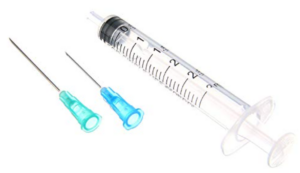
Topics Covered:
- What are the syringe tip types and orientations
- Use of different syringe tip types
- What are the needle tip types
- Use of different needle tip types
- How to prevent solution leaking
Why Knowing Syringe Tip and Needle Types is Beneficial
- Understanding the different syringe tip and needle types helps with the selection process overall.
- Choosing a syringe tip and needle type to best suit a specific application maintains accuracy.
- Using the appropriate syringe and needle type saves samples as well as resources.
There are several styles of syringe tip and needle types. Moreover, different syringe tip and needle types offer a wide array of application opportunities. It is imperative to select and use the most appropriate syringe tip and needle type during medical and research techniques. It’s also crucial to properly clean your syringe, and choose compatible chemicals. As a matter of fact, selecting the incorrect syringe tip or needle type may alter data analysis or waste your sample. The following is a brief syringe tip and needle type guide and their applications, especially Gas Chromatography Mass Spectrometry (GCMS) and High-Performance Liquid Chromatography (HPLC) applications.
What are Syringe Tip Types and Orientations
As can be seen below, is an image of 5 distinct syringe styles with labels, and the descriptions of each type (from left to right).
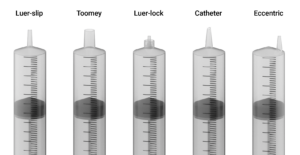
- Luer Slip Tip: Is a syringe tip that has a smooth tip which the needle hub slides onto.
- Toomey Tip: This smooth tipped syringe has one of the widest orifice diameters and is multi-purpose in its applications.
- Luer Lock Tip: Is a syringe tip with threaded tip that a needle hub can screw into. Subsequently, this stable attachment inhibits the needle from disconnecting and leaking.
- Catheter Tip: Is syringe tip that consists of a tapered end tip.
- Eccentric Tip: Has an off-centered tip.
Use of Different Syringe Tip Types
There are, without a doubt, numerous applications that the different styles of syringe tips can be utilized in. Below each syringe tip type, though not an exhaustive list, are examples of applications that the can be used for.
Luer Slip Syringe Tip Applications 
- Preparation and administration of medicines and fluids involving recurring needle changes
- Intramuscular (IM) and subcutaneous (Sub-Q) injections
- Sample collection and transfer
- Liquid handling and measurements (dilutions and mixtures)
- Wound cleaning and aspiration
- Electronic and small assembly operations
Toomey Syringe Tip Applications 
- Wound or surgical flushing, remove debris, or applying antiseptics
- Injection, aspiration, and irrigation during surgery and other procedures
- Deliver nutrition to feeding tubes
Luer Lock Syringe Tip Applications 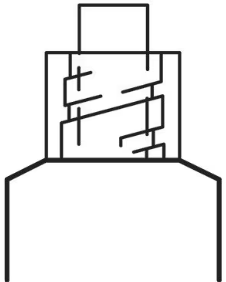
- Intramuscular (IM), subcutaneous (Sub-Q), and intravenous (IV) injections to administer medications and other solutions
- Septum puncturing
- Small volume tube washing
Catheter Syringe Tip Applications 
- Flush or clean wounds or medical tubing
- Injection, aspiration, and irrigation during medical procedures
- Deliver nutrition to feeding tubes
- Medical manufacturers can also make attachable catheter tips, with the tapered end, to slip on and off other syringe tip types
Eccentric Syringe Tip Applications 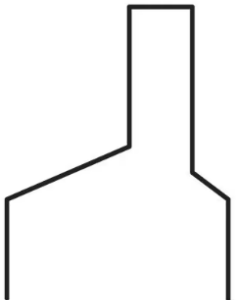
- Intravenous (IV) and, parallel to the skin, Intradermal (ID) injections
- Venipuncture (blood draw) and sample collection
- Aspiration of fluids and medications
What are the Needle Tip Types
The following picture is of 6 different types of needle points and descriptions of their distinguishing features (from top to bottom).
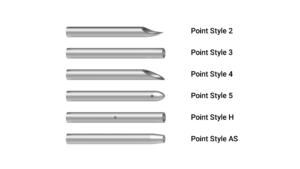
- Point Style 2: Beveled, curved, sharp, sloping edge, non-coring needle point.
- Point Style 3: Blunt needle tip (90° angle).
- Point Style 4: Standard beveled point (12° angle).
- Point Style 5: Conical needle point with a side port.
- Point Style H: Blunt tip with a side port.
- Point Style AS: Conical, non-coring, blunt tip (90° angle).
Use of Different Needle Tip Types
Similarly like each type of syringe tip, the styles of needle tips are employable across countless applications. In addition, every style of needle tip can be made with a compatible hub, the back of the needle, to fit one of the syringe tip types. With this in mind, here are some applications that the different needle points are utilized in listed below.
Point Style 2 Applications
- Septa penetration without coring
- Chromatographic techniques
- Occasionally may have a bend in a manner that partially obstructs the orifice
Needle Tip Point Style 3 Applications
- Routine sample uptake or pipetting
- Suitable for entire sample extracted from the tube because there is no possibility of septum coring
- HPLC injection valves
Needle Style 4 Applications
- Intramuscular (IM), intradermal (ID), intraperitoneal (IP), subcutaneous (Sub-Q), and intravenous (IV) injections for administrating medication and other solutions
Point Style 5 Applications
- Gas chromatography mass spectrometry manual injection
- Also, the side port creates a self-sealing entry point (no coring) for septa penetration
- Fluid sample uptake and infusion occur through the side port
- Point style 5 may extend the lifetime of septa as a result
H Point Style Applications
- High-Performance Liquid Chromatography (HPLC) manual injection
- Side port needles are for sample uptake and release, and they also minimize the potential of a piece of septum becoming lodged in the needle shaft
- Concurrently, this blunt needle minimizes the possibility of damage to the HPLC injection port or septa
AS Point Style Applications
- Auto-Sampling
- Furthermore, AS needle tips can withstand multiple, rapid injections without damaging the instrument injection port or causing coring
How to Prevent Solution Leaking
Additionally, it is necessary to ensure that solutions don’t leak from your syringe and needle tip prior to sample injection. There are two generally easy methods to avoid this problem:
- Air bubble elimination in a microfluidic device. Fully immersing the syringe needle tip in your solution during sample extraction (possibly by holding your solution vial upside down) will help prevent air uptake into the syringe.
- Lastly, wait approximately two seconds between sample uptake and removing the needle from your solution. This is typically sufficient time for the purpose of equalizing the pressure in the syringe barrel with the surrounding air.

